A Deep Dive into Senate Bill 8
Senate Bill 8 appropriates a total of $13.3 billion in ARPA funding towards multiple categories of uses, with the bulk going toward addressing the state’s unemployment insurance deficit and COVID-related healthcare and response costs.
Unemployment Compensation
$7.2 billion, more than half of the $13.3 billion in ARPA funding, was appropriated to replenish the Unemployment Compensation Fund. This appropriation helps employers avoid future cost increases and addresses the shortfall in the state’s Unemployment Compensation Fund which was hit hard by the job losses Texans experienced in 2020.
As noted in our Federal Funds Playbook, appropriating $7 billion to replenish the state’s Unemployment Compensation Fund was supported by 58% of Texans. And according to testimony received during the legislative process, this appropriation should prevent the state from increasing taxes on Texas employers by as much as an estimated 266 percent increase in their unemployment taxes.
Healthcare and COVID-19 Response
The $2.8 billion appropriated for healthcare and COVID-19 response addresses issues caused by the pandemic since March 2021. Highlights include:
 $2.0 billion for COVID-19 response: An allocation of $2.0 billion in SFR Funds to the Department of State Health Services provides funding for surge staff at state and local healthcare facilities, the purchase of therapeutic drugs, and the operation of regional infusion centers.
$2.0 billion for COVID-19 response: An allocation of $2.0 billion in SFR Funds to the Department of State Health Services provides funding for surge staff at state and local healthcare facilities, the purchase of therapeutic drugs, and the operation of regional infusion centers.- $378.3 million for pandemic staffing needs: This funding is allocated to the Health and Human Services Commission and will provide one-time grants for critical staffing needs of frontline health care workers affected by COVID-19, including recruitment and retention bonuses.
- $286.3 million for TRS-Care Programs: This funding is allocated to the Teachers Retirement System to cover coronavirus-related claims in TRS-Care and TRS-ActiveCare, the health benefit plans available to many retired and active Texas teachers.
- $75 million for rural hospitals: This funding is allocated to the Health and Human Services Commission to provide grants to rural hospitals that have been negatively affected by the pandemic.
Justice and Public Safety
The $656.6 million appropriated for justice and public safety went to shore up court fee and sexual assault program shortfalls, crime victims grant funding streams and salaries at Texas Department of Criminal Justice.
 $107.1 million for crime victims and sexual assault funding shortfall: An allocation of $107.1 million in SFR Funds to the Office of the Attorney General will help shore up accounts that have seen demand increases during the pandemic at the same time experiencing an estimated 16.7% decline in revenue in FY 20, according to the Office of the Attorney Generals appropriations request.
$107.1 million for crime victims and sexual assault funding shortfall: An allocation of $107.1 million in SFR Funds to the Office of the Attorney General will help shore up accounts that have seen demand increases during the pandemic at the same time experiencing an estimated 16.7% decline in revenue in FY 20, according to the Office of the Attorney Generals appropriations request.- $160 million for crime victims’ grants: An allocation of $160.0 million in SFR Funds to the Office of the Governor will help close funding gaps created by a reduction in other federal funding sources. These grants assist nonprofit organizations in offering vital services to adult and child victims of crime.
- $29.9 million for court fee shortfall: This funding will address the backlog of criminal cases we’ve recently highlighted and help avoid future costs to taxpayers.
- $359.7 million for public safety salaries: This funding will swap the method of finance used to pay for certain employee salaries at the Texas Department of Criminal Justice, resulting in general revenue savings.
Broadband and Emergency Communications
The $650.5 million appropriated for broadband and emergency communications builds off the work completed during the regular legislative session with the passage of House Bill 5 (87R) and House Bill 2911 (87R).
 $500.5 million for Broadband Infrastructure: These Coronavirus Capital Projects Funds will go to the newly established Broadband Development Office to expand broadband infrastructure across the state. As highlighted in previous posts, this funding represents a down payment on what is expected to be a multibillion-dollar investment for Texas to narrow the digital divide.
$500.5 million for Broadband Infrastructure: These Coronavirus Capital Projects Funds will go to the newly established Broadband Development Office to expand broadband infrastructure across the state. As highlighted in previous posts, this funding represents a down payment on what is expected to be a multibillion-dollar investment for Texas to narrow the digital divide.- $150 million for Next Generation 9-1-1: This allocation of SFR Funds to the Commission on State Emergency Communications will help those areas of the state that do not have Next Generation 9-1-1 infrastructure, which improves emergency communications for Texans and first responders.
Education and Workforce
The bulk of the $467.2 million appropriated for education and workforce went toward debt service on bonds for capital projects as well as institutional enhancements at two universities.
 $325 million for university construction: The Higher Education Coordinating Board received this amount for capital projects at various universities, tied to the passage of the separate tuition revenue bond bill (SB 52).
$325 million for university construction: The Higher Education Coordinating Board received this amount for capital projects at various universities, tied to the passage of the separate tuition revenue bond bill (SB 52).- $100 million for institutional enhancements: This appropriation is split evenly between Texas Tech University and the University of Houston.
- $21 million for At-Risk Students and Veterinarian Grants: The Higher Education Coordinating Board was appropriated $20 million to provide support for students who meet the definition of at-risk as well as $1 million for a veterinarian grant program
- $15 million for Reskilling/Upskilling Texans: The Texas Higher Education Coordinating Board will use these funds for the purpose of operating the Texas Reskilling and Upskilling through Education (TRUE). One example of how these funds can be used is to provide students with financial aid to attend eligible reskilling or upskilling programs offered by Texas community colleges or other eligible workforce training providers.
- $3.2 million for Miscellaneous Higher Education Projects: $3.2 million in SFR Funds were used for various programs at specific universities to support museums and other research initiatives.
- $3 million for Big Brothers Big Sisters Program: The Texas Education Agency received funding for the Big Brothers Big Sisters program technological staff enhancements.
Texas 2036 supported the passage and implementation of the TRUE initiative (SB 1102, 87-R) and continues to work through the Aim Hire Texas coalition to ensure that educational investments lead to high-value workforce outcomes, both for students and employers.
However, the $325 million appropriation for university construction may not be within allowable uses according to interim final rules at the U.S. Treasury Department, to the extent the funding is used to pay for debt associated with tuition revenue bonds. Section 51 of the bill notes that these funds are categorized as “government services” under applicable Treasury guidelines, meaning that they have the broadest allowable uses under ARPA (subject to a $12.2 billion limit). That said, despite the broad allowable uses, Treasury’s interim final rule states that “government services would not include interest or principal on any outstanding debt instrument, including, for example, short-term revenue or tax anticipation notes, or fees or issuance costs associated with the issuance of new debt.” Section 10(b) of Senate Bill 8 provides that the state will backfill this appropriation with general revenue if ARPA funding is disallowed.
Mental Health
The $405.9 million appropriated for mental health will help expand Texas’ physical infrastructure as well as access to services.
 $292.8 million for Mental Health Facilities: $237.8 million was appropriated to the Health and Human Services Commission to construct a new state hospital in the Dallas area. In addition, the Legislature allocated $15 million to enhance a mental health facility in Lubbock as well as $40 million to the Texas Facilities Commission for the construction of a behavioral health facility in the Permian Basin.
$292.8 million for Mental Health Facilities: $237.8 million was appropriated to the Health and Human Services Commission to construct a new state hospital in the Dallas area. In addition, the Legislature allocated $15 million to enhance a mental health facility in Lubbock as well as $40 million to the Texas Facilities Commission for the construction of a behavioral health facility in the Permian Basin.- $113.1 million for the Children’s Mental Health Services: This appropriation of SFR Funds to the Higher Education Coordinating Board will support the operations and expansion of the Texas Child Mental Health Care Consortium, which leverages the expertise and capacity of health-related institutions of higher education to help improve the mental health care system for children and adolescents.
In previous posts we’ve highlighted the fact that Dallas is a key metropolitan area with many health care systems and medical school resources, but it does not have a state hospital. Using ARPA funds to construct this facility will increase access to necessary care and offset future planned state general revenue expenses. The Legislature will need to monitor the on-going non-infrastructure costs for these new mental health services and their impact on future state budgets.
Emergency Infrastructure and Resiliency
The $306.5 million appropriated for emergency infrastructure and resiliency will bolster our ability in responding to extreme weather events.
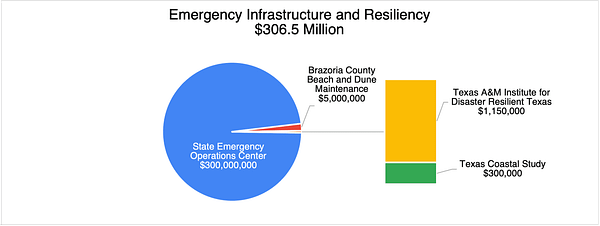 $300 million for State Operations Facilities: $300 million was appropriated to the Division of Emergency Management to construct a new state operations center.
$300 million for State Operations Facilities: $300 million was appropriated to the Division of Emergency Management to construct a new state operations center.- $5 million for Beach and Dune Maintenance: These funds will help combat beach erosion and bolster dunes that will help protect our coastal communities in Brazoria County.
- $1.5 million for Resiliency Studies: $1.2 million was appropriated to study flood risk for infrastructure in historically underserved areas, and $300 thousand was appropriated for an analysis of the Coastal Texas Study at the General Land Office.
Texas’ future depends on how we prepare for more extreme weather, a point we’ve made before in our work with State Climatologist Dr. Nielsen-Gammon. Appropriations to improve flood prevention capabilities were supported by 79% of Texans, including 88% of Houstonians.
Economic Recovery
The $280 million appropriated related to Texas’ economic recovery will provide support to the tourism industry, which was hit hard by the pandemic, as well as provide critical funding for food pantries.
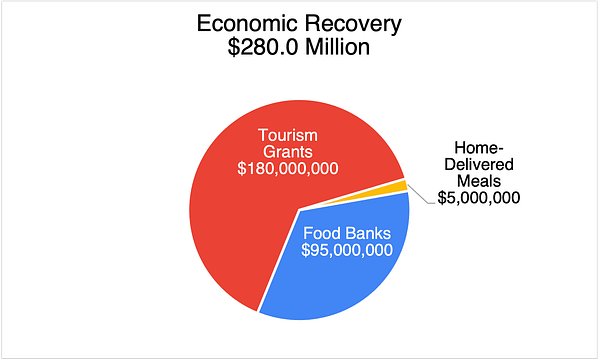 $180 million for Tourism Grants: The Office of the Governor will use these funds for grants to support the recovery of our tourism, travel, and hospitality industry.
$180 million for Tourism Grants: The Office of the Governor will use these funds for grants to support the recovery of our tourism, travel, and hospitality industry.- $100 million for Food Banks & Home Meal Delivery: The Texas Department of Agriculture received $95 million dollars to help support food banks and $5 million dollars for home meal delivery services.
Information Technology and Cybersecurity
The $226.2 million appropriated for IT and Cybersecurity items will build off the work completed during the regular legislative session with the passage of House Bill 4018 (87R).
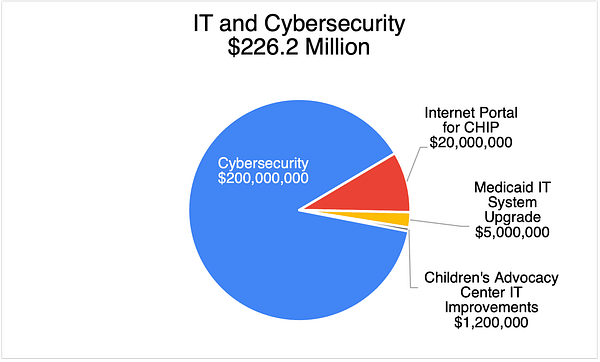 $200 million for Cybersecurity: The Texas Department of Information Resources will use these funds to update state IT resources that could potentially cause cybersecurity issues.
$200 million for Cybersecurity: The Texas Department of Information Resources will use these funds to update state IT resources that could potentially cause cybersecurity issues.- $20 million for CHIP internet portal and $5 million for Medicaid IT systems upgrade: With these funds, the Texas Health and Human Services Commission will streamline enrollment, credentialing, and data management for medical providers in Medicaid and the Children’s Health Insurance Program (CHIP).
- $1.2 million for Child Advocacy Center IT upgrades:
This funding will improve our state’s ability to deliver services and improve our cybersecurity posture by updating IT resources and preventing future costs, a topic that we’ve discussed in the past. The Texas 2036 voter poll showed overwhelming support from Texas voters for modernizing state information technology, with 80% support.
Government Facilities
$175.5 million was appropriated for deferred maintenance and new construction at state-owned facilities.
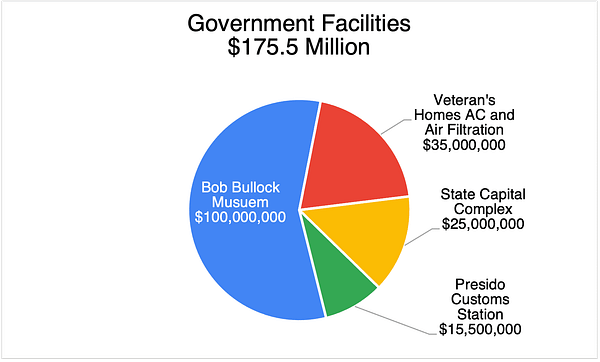 $100 million to the Safekeeping Trust for the Bob Bullock Museum: These funds were appropriated to the Texas Treasury Safekeeping Trust Company for the State Preservation Board to maintain the Bob Bullock State History Museum.
$100 million to the Safekeeping Trust for the Bob Bullock Museum: These funds were appropriated to the Texas Treasury Safekeeping Trust Company for the State Preservation Board to maintain the Bob Bullock State History Museum.- $35 million for HVAC and Air Filtration System Upgrades: The General Land Office received SFR Funds to upgrade the HVAC systems at Texas State Veterans Homes.
- $25 million to the State Preservation Board: The State Preservation Board will use these funds for the purpose of maintenance and capital improvement projects for facilities under its jurisdiction, such as the Texas Capitol, the 1857 General Land Office Building, the Texas Governor’s Mansion, the Bullock Texas State History Museum, and the Texas State Cemetery.
- $15.5 million for the Presidio Customs Station: The Texas Department of Transportation will use these funds to construct a customs inspection station on the South Orient Rail line in Presidio.
Funding maintenance needs with ARPA funds will save the state general revenue dollars for other items in the future and ensure Texans have up-to-date facilities. However, the $100 million allocated on behalf of the Bullock Museum may not be within allowable ARPA uses according to interim final rules issued by the U.S. Department of Treasury. Section 51 of the bill notes that these funds are categorized as “government services” under applicable Treasury guidelines, meaning that they have the broadest allowable uses under ARPA (subject to a $12.2 billion limit). That said, despite the broad allowable uses, Treasury’s interim final rule states that “replenishing financial reserves (e.g., rainy day or other reserve funds) would not be considered provision of a government service, since such expenses do not directly relate to the provision of government services.” Recognizing this risk, Senate Bill 8 provides that if the funding is not allowable, the state will backfill this appropriation with general revenue.
State Parks and Historic Sites
The $63 million appropriated for state parks and historic sites will fund grant programs and facilities’ needs at the Texas Parks and Wildlife Department as well as the Texas Historical Commission.
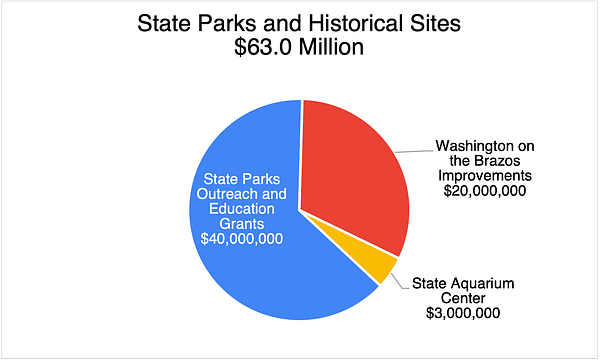 $40 million for Education and Outreach Programs: These funds will be spent by the Texas Parks and Wildlife Department to increase awareness, participation, revenue, and compliance at state parks and programs.
$40 million for Education and Outreach Programs: These funds will be spent by the Texas Parks and Wildlife Department to increase awareness, participation, revenue, and compliance at state parks and programs.- $3 million for Texas State Aquarium: This allocation of SFR Funds will be used for wildlife research at the Texas State Aquarium in Corpus Christi.
- $20 million for Washington-on-the-Brazos site: The Texas Historical Commission will use these funds for a capital plan project for the Washington-on-the-Brazos state historic site.
Improved Transparency and Accountability
Budgets represent priorities, and while increased funding is important, being able to track outcomes tied to funding increases is ideal. As the bill passed the House, it would have required public-facing reporting on all federal coronavirus funds. The final version requires the Legislative Budget Board in consultation with the Comptroller to publicly report on a quarterly basis how federal funds appropriated under Senate Bill 8 were spent through 2028.


 $2.0 billion for COVID-19 response: An allocation of $2.0 billion in SFR Funds to the Department of State Health Services provides funding for surge staff at state and local healthcare facilities, the purchase of therapeutic drugs, and the operation of regional infusion centers.
$2.0 billion for COVID-19 response: An allocation of $2.0 billion in SFR Funds to the Department of State Health Services provides funding for surge staff at state and local healthcare facilities, the purchase of therapeutic drugs, and the operation of regional infusion centers. $107.1 million for crime victims and sexual assault funding shortfall: An allocation of $107.1 million in SFR Funds to the Office of the Attorney General will help shore up accounts that have seen demand increases during the pandemic at the same time experiencing an estimated 16.7% decline in revenue in FY 20, according to the Office of the Attorney Generals appropriations request.
$107.1 million for crime victims and sexual assault funding shortfall: An allocation of $107.1 million in SFR Funds to the Office of the Attorney General will help shore up accounts that have seen demand increases during the pandemic at the same time experiencing an estimated 16.7% decline in revenue in FY 20, according to the Office of the Attorney Generals appropriations request. $500.5 million for Broadband Infrastructure: These Coronavirus Capital Projects Funds will go to the newly established Broadband Development Office to expand broadband infrastructure across the state. As highlighted in previous
$500.5 million for Broadband Infrastructure: These Coronavirus Capital Projects Funds will go to the newly established Broadband Development Office to expand broadband infrastructure across the state. As highlighted in previous  $325 million for university construction: The Higher Education Coordinating Board received this amount for capital projects at various universities, tied to the passage of the separate tuition revenue bond bill (SB 52).
$325 million for university construction: The Higher Education Coordinating Board received this amount for capital projects at various universities, tied to the passage of the separate tuition revenue bond bill (SB 52). $292.8 million for Mental Health Facilities: $237.8 million was appropriated to the Health and Human Services Commission to construct a new state hospital in the Dallas area. In addition, the Legislature allocated $15 million to enhance a mental health facility in Lubbock as well as $40 million to the Texas Facilities Commission for the construction of a behavioral health facility in the Permian Basin.
$292.8 million for Mental Health Facilities: $237.8 million was appropriated to the Health and Human Services Commission to construct a new state hospital in the Dallas area. In addition, the Legislature allocated $15 million to enhance a mental health facility in Lubbock as well as $40 million to the Texas Facilities Commission for the construction of a behavioral health facility in the Permian Basin. $300 million for State Operations Facilities: $300 million was appropriated to the Division of Emergency Management to construct a new state operations center.
$300 million for State Operations Facilities: $300 million was appropriated to the Division of Emergency Management to construct a new state operations center. $180 million for Tourism Grants: The Office of the Governor will use these funds for grants to support the recovery of our tourism, travel, and hospitality industry.
$180 million for Tourism Grants: The Office of the Governor will use these funds for grants to support the recovery of our tourism, travel, and hospitality industry. $200 million for Cybersecurity: The Texas Department of Information Resources will use these funds to update state IT resources that could potentially cause cybersecurity issues.
$200 million for Cybersecurity: The Texas Department of Information Resources will use these funds to update state IT resources that could potentially cause cybersecurity issues. $100 million to the Safekeeping Trust for the Bob Bullock Museum: These funds were appropriated to the Texas Treasury Safekeeping Trust Company for the State Preservation Board to maintain the Bob Bullock State History Museum.
$100 million to the Safekeeping Trust for the Bob Bullock Museum: These funds were appropriated to the Texas Treasury Safekeeping Trust Company for the State Preservation Board to maintain the Bob Bullock State History Museum. $40 million for Education and Outreach Programs: These funds will be spent by the Texas Parks and Wildlife Department to increase awareness, participation, revenue, and compliance at state parks and programs.
$40 million for Education and Outreach Programs: These funds will be spent by the Texas Parks and Wildlife Department to increase awareness, participation, revenue, and compliance at state parks and programs.